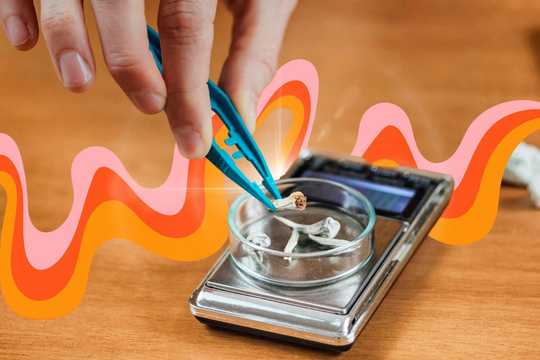Somatic therapy is a form of trauma therapy. It explores how the body expresses deeply painful experiences and how working with the body can be a way of processing and releasing such pain. The public’s interest in this approach has been reflected in the resounding success of The Body Keeps the Score (2014). Psychiatrist Bessel van der Kolk’s book remained on the New York Times bestseller list for more than four years running.
In the realm of psychedelic therapy, many different psychotherapeutic approaches can be applied. This has led to discussions about which approaches will be most relevant and effective, and what an integrated strategy might look like. Models that have been applied in psychedelic-assisted therapy have included psychodynamic, transpersonal, and cognitive-behavioral ones. However, many practitioners—and clients—feel that somatic therapy is needed and should at least be integrated with other approaches.
In this article, we will be examining what the evidence so far tells us about the efficacy of somatic therapy. We’ll look at the relevance of this model to psychedelics, and whether all of the claims of somatic therapy proponents can be backed up.
How Somatic Therapy Works
A somatic therapist helps people release damaging, pent-up emotions held in their body by using a range of mind-body techniques. These can vary widely, ranging from meditation and breathwork to acupressure and dance.
Practitioners of somatic therapy view the mind and body as inherently linked. They also believe that trauma can get trapped inside our bodies and affect our mental health. This form of therapy is intended to heal people on a cellular level.
Emotions get trapped in the body because, after a traumatic event, the nervous system stays stuck in survival mode. The idea is that in this state, stress hormones are continually released. When the body is under this constant level of stress, physical and psychological symptoms emerge. Somatic therapy practitioners may point to the phenomenon of animals shaking off their trauma and stress after scares, like nearly being eaten, in order to ‘move through’ the danger. This response calms their nervous system and quiets the ‘fight or flight’ response.
Somatic Experiencing (SE) is a popular type of somatic therapy, developed by Dr. Peter Levine. His book, Waking the Tiger: Healing Trauma (1997) focuses on how emotions appear within the body. During SE treatment, you may be asked to describe the physical sensations you felt during a traumatic event. A therapist will guide you in releasing built-up energy safely. This often manifests as shaking, trembling, shivering, or spasms but can also express itself through yawning or crying.
The Evidence for Somatic Therapy’s Efficacy
There is evidence that somatic therapy can offer effective relief for those struggling with post-traumatic stress disorder (PTSD). Randomized controlled trials (RCTs) – typically considered to be the gold standard of research – show that SE can lead to significant reductions in PTSD symptoms. Other studies on survivors or victims of trauma have shown that SE is effective at reducing somatic and anxiety symptoms. They have also shown effectiveness in increasing physical and relational well-being.
Further Benefits of Somatic Therapy
Other benefits highlighted by research on SE include:
- Decreased stress
- Reduced irritability and/or aggression
- Improved concentration
- Higher levels of self-esteem
- Improved confidence
- Increased hope
- Increased resiliency
- Improved sleeping
- Heightened interest in activities
Research Limitations
Despite a number of studies showing benefits, there are several limitations with the research so far:
- Scarcity of published studies. Only a handful of studies on SE have been published in scientific journals.
- Methodological limitations. The published research available is limited to small sample sizes and specific groups. SE should be further tested using RCTs with active control groups, such as traditional or other alternative therapies. For instance, a study conducted by Andersen et al. (2020) revealed that SE, as an add-on treatment to traditional physiotherapy, did not yield additional benefits [1].
- Reliance on clinical experience and anecdotal reports. Most of the evidence that SE practitioners like Levine rely on comes from clinical experience. While valuable, it does not ensure that treatment and improvements are causally related. Also, the application of interventions is often based on anecdotal evidence, which may not be reliable. In addition, applying observations of animal behavior – such as their responses to trauma – to humans is tricky. It is not always clear why and under what conditions this natural response is deployed. However, a better understanding of this could allow us to make such extrapolations.
- Trauma may not literally be stored in the body. The question of whether trauma is stored in the body (not just in the brain) – in the tissue and cells – and has to be released through shaking and other somatic responses is a contentious one. Traumatic memories may not literally be stored in cells throughout our body, but they can certainly leave a physical mark, in which case ‘stored’ is used in more of a metaphorical – and not strictly scientific or literal – sense.
Can Psychedelics Help Us Shake Off Trauma?
It is common for many people to find themselves shaking, trembling, shivering, or spasming during a psychedelic experience. This is often reported as involuntary, coming out of nowhere. But it can feel like a kind of release, leading to a state of euphoria and calm. Does this indicate that psychedelics are addressing trauma on a deep, somatic level? Saj Razvi, the Founder and Director of Education at the Psychedelic Somatic Institute, believes this is the case. He thinks these physical reactions are an essential component of how psychedelics heal us. He states:
“I think there is a fair amount of the population who are turning to psychedelics because they’re kind of sick of traditional talk therapy. They could be in therapy for 20 years and understanding why something happens doesn’t necessarily change the symptoms on the ground.”
He adds:
“I think the somatic therapies can start to get at it a little bit but if you don’t have the support of a psychedelic on board, I don’t see anybody opening up to the true exquisite pain of what that traumatic wound is about. But we go there pretty reliably with the aid of psychedelics.”
Exploring the Role of Psychedelics in Trauma Healing
Psychedelic somatic therapy may help individuals learn that somatic responses like shaking and crying can be safe and effective tools for emotional regulation. There is an especially promising aspect of the psychedelic state in the context of somatic therapy. Shaking can occur spontaneously and be intense and prolonged, which can feel like a much-needed release of tension. Krystine Grace, who found ayahuasca helpful in dealing with the root cause of depression and addiction, told HealingMaps:
“Basically, all [psychedelics] have their own way of creating different releases in the body. Especially with ayahuasca, psilocybin, and 5-MeO-DMT, there is shaking, yawning, burping, purging—not necessarily of actual physical substance, but of energy that’s stuck in the body.”
Conversely, shaking behavior (head twitches and/or wet dog shakes) is considered to be a reliable effect of psychedelic drug action. This shaking behavior is thought to be mediated by serotonin 2A receptors, which has been confirmed in studies [2]. Thus, shaking may not necessarily be a sign of shaking off deeply held tension and trauma but may be the result of psychedelic action on serotonin receptors. As such, people without unprocessed trauma may find themselves involuntarily and uncontrollably shaking during a psychedelic journey as well.
All in all, somatic therapy shows promise as an effective treatment for dealing with trauma. Many practitioners and users of psychedelics find it a relevant modality for therapeutic psychedelic journeys. However, whether psychedelics can heal us through the intense shaking that can occur needs to be further studied.
Follow your Curiosity
Sign up to receive our free psychedelic courses, 45 page eBook, and special offers delivered to your inbox.References
Andersen, T. E., Ellegaard, H., Schiøttz-Christensen, B., Mejldal, A., & Manniche, C. (2020). Somatic Experiencing® for patients with low back pain and comorbid posttraumatic stress symptoms – a randomized controlled trial. European Journal of Psychotraumatology, 11(1), Article: 1797306. https://www.ncbi.nlm.nih.gov/pmc/articles/PMC7473216/
Buchborn, T., Lyons, T., Song, C., Feilding, A., & Knöpfel, T. (2023). Cortical Correlates of Psychedelic-Induced Shaking Behavior Revealed by Voltage Imaging. International Journal of Molecular Sciences, 24(11), Article: 9463. https://www.mdpi.com/1422-0067/24/11/9463







